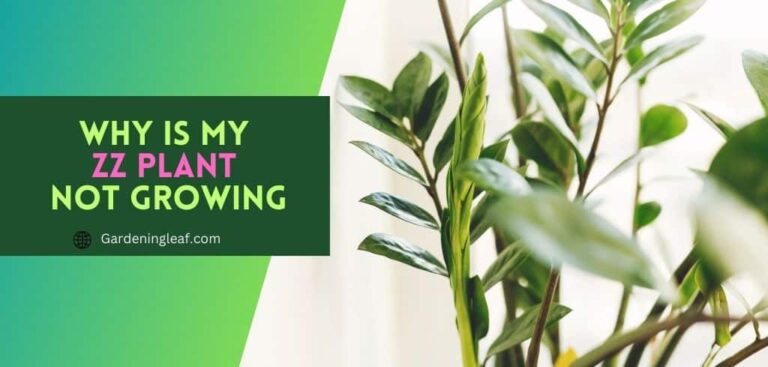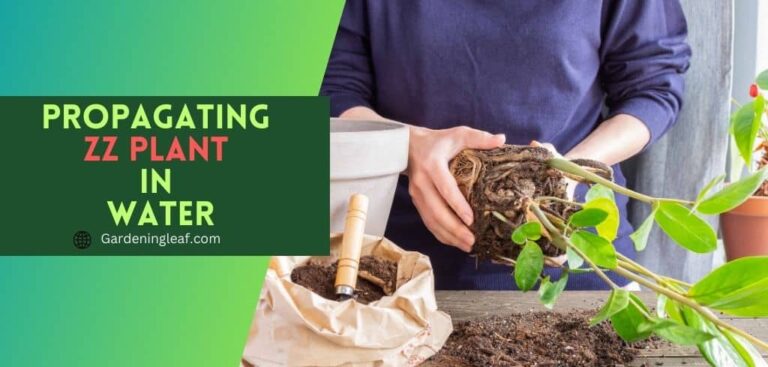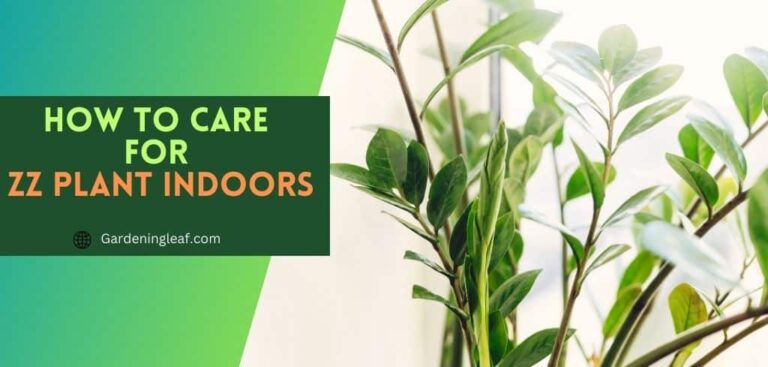10 Signs My ZZ Plant Dying and How to Fix It
Is your ZZ plant not looking as healthy as it once did? Don’t worry; we will discuss the top 10 signs that your ZZ plant dying and needs help.
From yellowing leaves to exposed root bulbs, we will cover each sign in detail to help you identify the problem with your plant. Also, share some tips on how to save a dying ZZ plant.
10 Signs Your ZZ Plant is in Trouble
Some houseplant owners may not even realize that their beloved ZZ plant is dying trouble until it’s too late. That’s why it’s important to be aware of the signs that your plant is struggling and needs some extra attention.
1. Yellowing Leaves
The ZZ plant leaves turning yellow is one of the most common indicators of something wrong. This might result from too much water or being underwater for too long.
So, it is necessary to conduct frequent inspections to determine the quantity of moisture in the soil. If the plant needs more water, revise the timetable for how often it will be irrigated appropriately.
Direct sunlight can also cause leaf burn and yellow leaves, so ensure your ZZ plant is not in direct sunlight. Also, nutrient deficiency may contribute to yellowing leaves.
Regularly fertilizing your ZZ plant to provide it with the necessary nutrients. If you notice wilting or drooping of leaves accompanied by yellowing. This may indicate root rot or other diseases.
It requires immediate action for your beloved ZZ plant’s survival.
2. Brown Leaves or Tips
Brown leaves or tips on your ZZ plant can indicate various issues, including overwatering, underwatering, or exposure to direct sunlight. If the soil is wet, cut back on excess water.
Additionally, consider moving the plant to a location with indirect sunlight if exposed to harsh light. To promote new growth, trim brown leaves and tips carefully.
And if the soil lacks nutrients, repotting your ZZ plant may help prevent further browning.
Read More :- How To Care For ZZ Plant Indoors: Effortless Care Guide
3. Scorched Leaves
When the ZZ plant’s leaves, get scorched. It means they have been exposed to too much direct sunlight or heat sources like radiators.
Move your plant to a location where it will be exposed to bright, indirect light to prevent it from suffering any further damage.
To prevent any potential damage, it is necessary to ensure that the object is positioned at a safe distance from any heat sources. This precautionary measure will ensure that the item remains in pristine condition and functions optimally for an extended period.
Once you’ve relocated your ZZ plant, remove any scorched leaves and monitor the plant for further signs of stress.
4. Dropping Leaves
If your ZZ plant’s leaf drop, it could be a sign of stress. One reason could be underwatering, but it could also indicate root rot or fungal diseases caused by overwatering or poor drainage holes.
You should figure out the amount of moisture in the soil before you water it. You will be able to prevent overwatering by doing this.
Regular pruning and repotting can help keep your ZZ plant healthy and avoid disease.
5. Black Spots on Stems and Leaves
This can signify rot caused by overwatering or exposure to cold temperatures.
It’s a cause for concern when you see black patches on the stems and leaves of your ZZ plant. They are often a sign of fungal or bacterial disease, which could spread quickly if left untreated.
Overwatering or poor drainage can also cause black spots to form on the plant.
Remove problematic leaves and stems and adjust the watering habit to fix this issue. Ensure that your ZZ plant is not sitting in water and let the soil dry out in between waterings.
Consider applying a fungicide to prevent further damage. Also, avoid placing the plant in areas with cold drafts.
6. Bending Stems

Bending stems are a clear sign that your ZZ plant is in distress. In addition, it is important to act on remedial actions before the situation becomes even more dire.
If the stems of your ZZ plant are bending, it may be because they are not receiving enough light. ZZ plants thrive in bright yet indirect light if they don’t receive enough light.
They fortify themselves and extend toward the light source, which causes the plant’s stems to curve.
To resolve this problem, relocate your plant to a more brightly lit area, protecting it from direct sunlight.
If the stems have already bent, you can try straightening them out by gently staking them with bamboo sticks or other support structures.
When carrying out this task, ensure that the stems are not harmed. Over time, as the plant gets more light, the stems should strengthen and straighten out independently.
Overwatering is another factor that can cause the plant to become heavy and the stems to bend. ZZ plants have thick, heavy leaves that can weigh down the stems. As a result, it is essential to provide sufficient support to avoid bending or even breaking.
Read More :- Why Is My ZZ Plant Not Growing: 8 Possible Reasons
7. Wrinkled Bulbs or Rhizomes
The health and well-being of a ZZ plant depend greatly on its bulbs or rhizomes. If these structures appear wrinkled, it indicates something is amiss.
Overwatering may cause the bulbs to become mushy and squishy, leading to root rot, while their exposure to underwater conditions can cause them to become dry and shriveled.
Adjusting your watering practices and ensuring that you are not over or underwatering the plant is essential to remedy this problem.
Additionally, repotting your ZZ plant after an extended period in the same pot can promote bulb health. Being attentive and addressing issues promptly can help your ZZ plant thrive for many years.
8. Slow or Poor Growth
Despite being low-maintenance and easy to care for, ZZ plants can exhibit slow or poor growth, which may indicate underlying problems.
ZZ growth can be limited by overwatering and insufficient light. ZZ plants are prone to suffering without adequate light while overwatering can cause root rot and stunted development.
Provide sufficient time for the soil to dry between each watering.
Some factors, including diseases, nutritional inadequacies, and improper potting methods, may cause slow growth. Therefore, it is essential to determine the reason behind the ZZ plant’s slow growth rate.
9. Pest infestations
If you notice pest infestations on your ZZ plant, it could indicate your ZZ plant dying. Pests such as spider mites, mealybugs, and scale insects are prominent examples of organisms that have the potential to cause harm to the plant’s leaves and stems.
These pests can cause significant harm if not addressed. They feed on the plant’s leaves and roots, weakening it and making it more vulnerable to illnesses and other problems.
If you fail to take prompt action, the plant may not recover and eventually die.
Therefore, inspecting your plant regularly for signs of pest infestations, such as tiny webs, white cotton-like masses, or small bumps on the leaves and stems, is crucial.
If you detect any insects on your ZZ plant, apply the proper pesticide and separate it from the other plants in your garden so that the infestation does not spread to them.
10. Fungal infections:
Fungal infections can also be a sign that a ZZ plant dying. Fungi thrive in moist conditions. So overwatering or allowing water to sit in the plant’s saucer can create an environment conducive to fungal growth.
Lack of adequate air circulation is another factor that may lead to fungal infections. as stagnant air traps moisture and creates a breeding ground for fungi.
Some common signs of fungal infections in ZZ plants include discoloration or wilting of leaves. A moldy or musty odor and fuzzy or powdery growth on the plant’s leaves or stems.
To prevent fungal infections, maintain proper watering habits and provide good air circulation to the roots. Fungicides can treat fungal infections and prevent them from spreading and damaging plants.
Read More:- Propagating ZZ Plant In Water: Easy Tips
How to Save a Dying ZZ Plant
When your ZZ plant is struggling and showing signs of decline. It can be stressful to figure out what went wrong and how to fix it.
There is good news in that certain actions may be taken to bring a ZZ plant back from the brink of death.
Identify the Problem
If you notice that your ZZ plant is showing signs of distress, such as yellow or brown leaves, stunted growth, wilting, or a mushy odor, it’s crucial to identify the root cause of the problem.
Check the plant’s leaves, stems, and roots for any indications of fungus infections, insect infestations, or other problems.
Once the issue has been determined, you can take the appropriate steps to address it and bring your ZZ plant back to life.
Adjust Watering and Sunlight Levels

To ensure the healthy growth of your ZZ plant, it is important to provide proper watering and sufficient sunlight. Both overwatering and underwatering may be harmful to a plant’s root system, which can result in stunted growth or even death.
ZZ plants are drought tolerant, although they need the top 2 inches of soil to dry out totally between waterings. So maintaining a proper watering schedule is important.
To ensure the health and growth of your plant, it’s important to safeguard it from extreme temperatures or drafts. It’s recommended to keep the plant in a brightly lit area with indirect sunlight and avoid places with high humidity or fluctuating temperatures.
You may use a humidifier to keep the humidity levels at ideal. Similarly, it is important to do periodic checks on the moisture content in the soil and to water the plant appropriately. Following these simple steps can help your ZZ plant thrive in its environment.
Read More:- How to prune a ZZ Plant
Nutrient Boost
Your ZZ plant needs proper nutrients to survive. If you see yellowing leaves, it may mean a lack of nitrogen, while brown tips may indicate a potassium deficiency.
Use fertilizer high in nitrogen, phosphorus, and potassium to revive your plant. However, you should avoid over-fertilizing as this can cause damage to the roots and cause the leaves to become charred. Instead, use organic or slow-release fertilizers for a gentle nutrient boost.
Proper nutrients will help your ZZ plant thrive and stay healthy for years.
Pruning
Pruning is a crucial part of its care to promote new growth and maintain the shape and size of a ZZ plant. By trimming dead and damaged leaves, the plant can be revived.
Using clean and sharp pruning shears and making clean cuts at the stem’s base is recommended. However, not cutting more than one-third of the plant at a time is essential, as excessive pruning can cause stress and shock.
Repotting
If your ZZ plant is still struggling after adjusting its care, repotting may be necessary to save it. Repotting means giving it fresh potting soil and more space to grow. ( Get proper ZZ plant potting soil )
Pick a new pot and new soil that suit your plant’s needs. Before repotting your plant in its new pot with new soil, carefully separate any tangled roots. Repotting can help save your ZZ plant by allowing it to recover and grow healthy again.
Pest Control
Pests can harm your ZZ plant and affect its growth. Insects like spider mites and mealybugs can damage leaves and stems. Check your plant regularly to identify pest infestations early.
If you find an infestation, you must immediately take measures to eradicate it. You may get rid of pests with natural solutions such as neem oil or insecticidal soap while protecting the beneficial insects in your garden at the same time.
Keeping your ZZ plant healthy by providing enough sunlight, water, and nutrients can help prevent pest attacks.
Conclusion
Zamioculcas Zamiifolia or ZZ plants are often hardy indoor plants, but they need the necessary care to maintain their strength. Don’t freak out if your ZZ plant seems to be dying.
Identify the issue and take corrective measures to revive it. Follow our guide to adjusting watering and sunlight levels, providing nutrient boosts, pruning, repotting, or controlling pests.
It’s always better to prevent problems than to cure them, so pay attention to your plant’s requirements and provide them with the right care and environment they need. Happy gardening!
Source :- https://www.magicbricks.com/blog/zz-plant-for-home/129007.html




